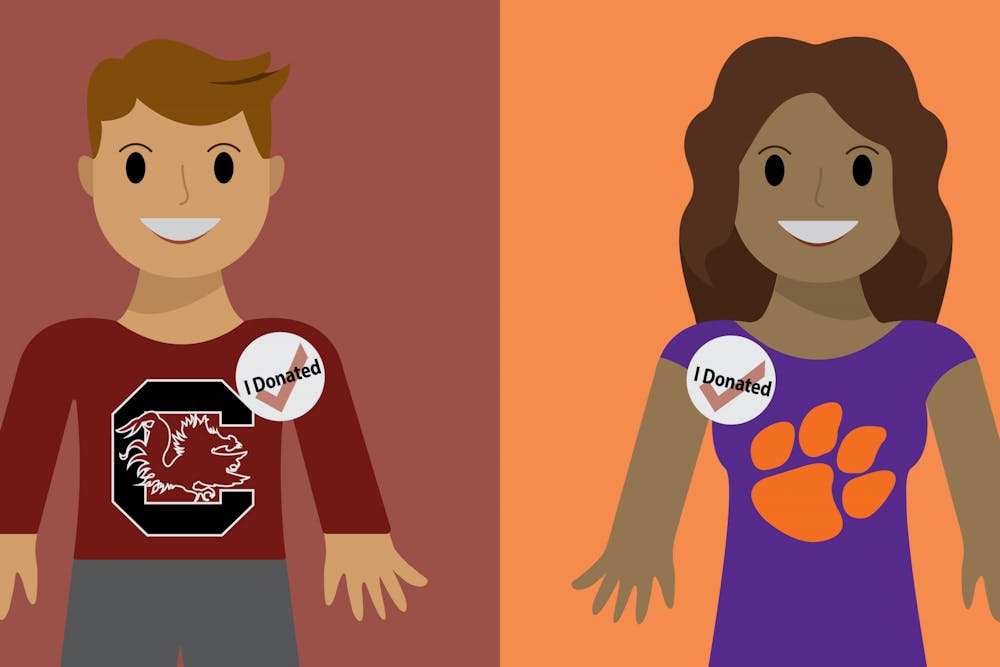The USC and Clemson rivalry, which spans over a century, is a healthy competition that bolsters students' school spirit.
The infamous rivalry between the two most prominent universities in South Carolina has most residents answering the question: Clemson or Carolina? Both students and alumni from each school do whatever they can to prove their school is better.
Many people think this rivalry started because of football, but it's much more than that, according to Andy Doyle, Winthrop's associate professor of history. Doyle studies Southern history with a focus on sports history, and he has published research on the topic of Southern football.
"The history of the rivalry is rooted in class distinction in the state of South Carolina," Doyle said.
USC was a college for the elite, while Clemson, known as an excellent agriculture school, was a trade school where kids could go to learn blue-collar work and "did not cater to the elite," according to Doyle. When football came to the South from the North after the Civil War, universities Southern elites, such as Carolina, were opposed to the idea of football. So while schools such as Clemson that embraced football were getting better, Carolina was not on the same level.
Doyle said this is because Clemson was a university that embodied the "New South ideology," while Carolina was much more traditionalist during the time football was being introduced to the South.
After years of playing and Clemson dominating the football scene, in 1902 Clemson came to South Carolina for the annual game. The Carolina team had a banner with Cocky perched on top of a dead tiger's head. This, of course, didn't go over well with the Clemson players, because it violated an ethos of honor throughout the South.
"A man's honor is his most prized possession, and you cannot let another man insult you, humiliate you, call you a liar, call you a thief, get in your face and publicly challenge your honor," Doyle said.
There, the rivalry was born. The Tiger Burn, where engineering students present the gigantic tiger they've been working on for the entire semester for students to burn, is a perfect example of the animosity between the two schools.
According to Doyle, USC won that game in 1902, and there was a big parade to celebrate. Clemson was a military school for decades, so students brought swords to defend its honor, where they were met with knives and guns on the Carolina side. This led to a riot, and the annual game was canceled until 1909.
Almost every year since 1896, USC and Clemson have played each other in the Palmetto Bowl. The Palmetto bowl was the longest continuous non-conference rivalry and went uninterrupted from 1908 until 2020, when it was not held due to COVID-19. Currently, the score stands at Clemson with 70 wins, Carolina with 43 and four ties.
While this rivalry has mostly been about football, it has sparked both schools to participate in school spirit and help their community. Most years, a week before the big game between South Carolina and Clemson, the schools have a competitive blood drive. Students, faculty, staff and anyone else in the community are encouraged to bleed garnet or orange for their team.
Over the past three decades, the universities have collected over 100,000 pints of blood for people in need right before the holiday season. This blood drive allows healthy competition between the two schools and gives back to the community.
Another competition the two universities have throughout the year concerns flu shots — students who get their flu shot self-report it to a survey to see which campus gets the most.
Although it might be rooted in bad blood, this rivalry is now something that South Carolinians can take pride in and use to give back to their community. This football game every year is a way to bring everyone together to cheer on their team, and while, unfortunately, Carolina loses most of the time, it's still a fun thing to look forward to and participate in with other students.

